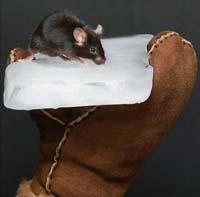Ice cannot be felt

German scientists discover a protein capable of feeling cold. It is called Nav1.8 and scientists knew it is also involved in the detection of damaged tissues. Moreover, the protein Nav1.8 intervenes in molecular processes to exaggerate the affected nerves and make feel the pain.
In short, to make the pain feel, the nervous system must transmit an electrical signal with neuron. In fact, the protein Nav1.8 helps to transmit the signal in the membrane of neurons. Scientists have also seen that protein also works at low temperatures. Therefore, when the origin of this pain is cold the protein Nav1.8 also works (for example when we catch a piece of ice in the hand).
Scientists have used a mouse to confirm the discovery. They have removed the protein Nav1.8, so the mouse has no ability to feel cold.





